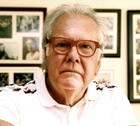The official report into the Black Hawk helicopter crash into the deck of HMAS Kanimbla in November 2006 spotlights a culture of slack safety standards in the Australian Army’s 171st Aviation Squadron.
The voluminous report, which followed a nine-month investigation, has just been handed to the Chief of Defence Force Air Chief Marshal Angus Houston who will decide how and when it will be made public.
He established the inquiry in the wake of the tragedy in which the helicopter’s pilot, Captain Mark Bingley, and SAS trooper Joshua Porter, were killed and seven other personnel injured.
Houston’s board of inquiry was the first of its kind for this type of event – it was open to the public and the media and not a closed internal inquiry internal to the Australian Defence Force, and it was headed by a civilian president with judicial experience, former NSW Supreme Court judge David Levine QC.
The other board members were service officers with defence expertise from the air force and the navy respectively, Group Captain Steve Fielder AM and Commander Andrew Rourke.
After public hearings in June, July and August 2007, taking evidence from 65 witnesses and accepting 290 exhibits, the inquiry has delivered a pointed – but diplomatically worded – judgement on the “gung-ho” approach of the army’s Black Hawk team.
Ruling out the possibility of mechanical failure, the report concentrates on the culture of aggressive and fast flying by the 171st and the poor quality of risk management and safety procedures during operations.
The board has apparently concluded that Bingley, a highly trained professional with “Top Gun” skills, misjudged the wind effects on the afternoon of the crash as well as the drift of the Kanimbla. He crash landed the Black Hawk 221 into the deck before it rolled into the Pacific Ocean and sank.
Evidence to the inquiry disclosed a prevailing culture that “great airmanship comes from flying the aircraft at its limits” and that the squadron’s approach was: “We can do it, we can handle it, we understand it.”
The board recommends the introduction of a tougher safety training regime for pilots and air crew and a risk management strategy allowing junior pilots to make known their concerns about the conduct of senior “elite” pilots.
The safety issues for the 171st are pressing. Later this year the squadron will complete its relocation from Townsville in north Queensland to the army base at Holsworthy in south-west Sydney where it will become a key element in the anti-terrorist strategy for Sydney, Canberra and the eastern seaboard.
The army’s aviation squadron is the frontline weapon in moving SAS teams, members of the Tactical Assault Group and the Incident Response Regiment into anti-terrorist, hostage and rescue operations. No one wants cowboys at the controls.








How do you think the families of these two men feel now!!! You call them cowboys yet they trained to do real life missions protecting Aust citizens in danger on foreign soin. My only hope is that one day they will be called to evacuate your family.